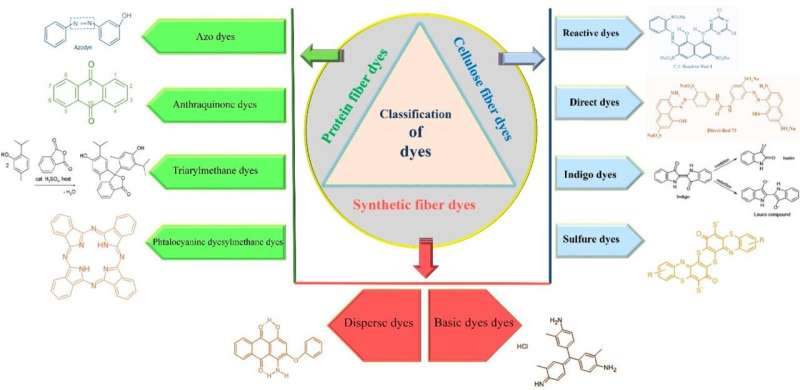This article has been reviewed according to Science X's editorial process and policies. Editors have highlighted the following attributes while ensuring the content's credibility:
fact-checked
trusted source
proofread
Q&A: Researcher unveils the health risks associated with synthetic fabric dyes

For millennia, humans have used natural materials—such as plants, animals and minerals—to imbue fabrics with vibrant colors. But synthetic dyes, first developed in the mid-19th century, have since displaced this age-old tradition.
These versatile, cost-effective and long-lasting dyes now dominate the textile industry. Yet this major shift to petrochemical dyes also carries significant environmental and health concerns, according to Concordia Public Scholar Vanessa Mardirossian.
Her previous work on this topic has been published in the journal Applied Sciences.
Of the 800,000 tons of synthetic dyes used annually, only a quarter makes it onto clothing. The rest seep into waterways and contribute to widescale environmental pollution. The chemical compounds found in dyes also enter our bodies.
These compounds are affecting our health in ways that we are only beginning to understand, says Mardirossian. Her research aims to raise awareness of the toxicity issues associated with synthetic dye practices worldwide to accelerate the ecological transition of the fashion industry.
A former textile designer, Mardirossian worked in the fashion industry for over 20 years, where she witnessed many of the negative effects of synthetic dyes firsthand. Now, the Ph.D. candidate in the Individualized Program (INDI) is melding research on textile design, chemistry and environmental health as part of her research-creation thesis.
She says she hopes to gain a better understanding of the effects of fashion dyes on our bodies and encourage the adoption of safer natural alternatives.
Mardirossian is also a lecturer at l'École supérieure de mode ESG-UQAM in Montreal. As part of her research, she is creating a "textile ecoliteracy." This educational concept will help the public—including consumers, designers and manufacturers—understand fashion production's impact on the natural world. Here, she discusses her research.
What first got you interested in studying dyes and toxicity?
When I was working in the fashion industry, I started to see more and more reports about this topic. I was curious because I had been working with colors for years as a textile designer. I had some personal health issues when I was working with dyes, but I didn't make the connection at first.
I had a studio where I was printing large pieces of fabric for haute couture. I was using a heat transfer press at 200°C to apply dispersive dyes onto polyester. The process involved breathing in the fumes from the dyes, and unfortunately, there was no ventilation in place, as I hadn't anticipated any interaction with the body at that time.
Throughout my four years in the workshop, conceiving my second child proved to be a significant challenge. While the pregnancies for my first and third children occurred effortlessly, the process for the second one involved numerous fertility treatments. Eventually, I became pregnant, but my child was born with a genetic mutation and still faces deep learning difficulties.
Doctors told me it was just bad luck and that there was no connection with the dyes. But the more I investigate synthetic dyes, the more the research suggests a connection. Synthetic dyes contain genotoxic and neurotoxic compounds that pose risks to the fetus. Exposure to genotoxic compounds can damage genetic material and lead to DNA mutations, increasing the risk of developmental issues in the fetus. Additionally, neurotoxic compounds have the potential to negatively impact the developing nervous system, potentially leading to cognitive issues in the child.
How are you going about your research?
At first, my goal was to gain a deeper understanding of the toxicity associated with synthetic dyes. With my supervisor in the Department of Chemistry, I analyzed the chemical composition of synthetic dyes. During the process, I came across an analysis method able to list the molecules present in the dyed fabric. Then, I studied their implications for human health with an environmental health doctor.
Using Liquid Chromatography analysis (LC-MS), I found carcinogenic molecules in specific samples. Then, my extensive scientific literature revealed that synthetic dyes may contain mutagenic and genotoxic compounds, impacting the body at very low doses due to daily chronic exposure. Many of these substances act as endocrine disruptors, potentially leading to cancer over extended periods. But, despite strong suspicions, establishing direct causation is challenging for environmental health researchers, as the impact of these molecules may take years to manifest.
I am now researching non-toxic alternatives to synthetic dyes. I'm conducting an in-depth literature review and interviewing numerous experts in the field of natural dyes. I want to contribute by sharing the best practices for developing non-toxic dyes.
What are some alternative approaches to textile dyes that are more sustainable and healthier?
A global network of experts, whom I interviewed as part of my methodology, is actively exploring non-toxic dye solutions through diverse approaches. Some experts are revitalizing ancient natural dye recipes, while others are adopting more forward-looking strategies involving living organisms such as bacteria, algae or fungi.
Personally, I focus on a biomimetic approach to color, drawing inspiration from ecosystem dynamics—specifically, their interdependence, proximity and circularity. In this model, each element cares for its surrounding living beings. This philosophy guides my creation of innovative dyes designed to interact positively with the environment.
I employ safe ingredients primarily sourced from the food industry's waste. This aligns with my interest in industrial ecology, where one industry's waste transforms into a resource for another.
My ongoing efforts involve actively exploring methods to reduce both the quantity of dye used and the amount of water required in the dyeing process. I have used pigment-producing bacteria to produce dyes at room temperature within 48 hours. These artistic experiments have led me to successfully craft over 300 unique shades aligned with the Pantone palette.



















